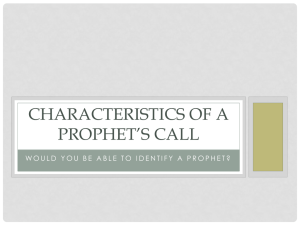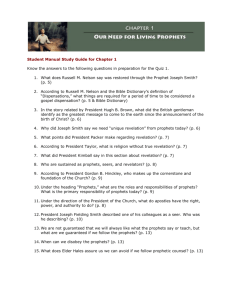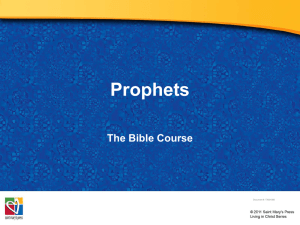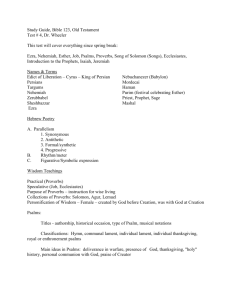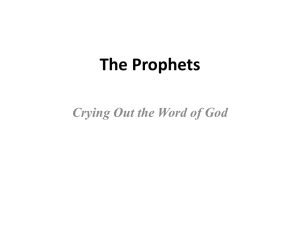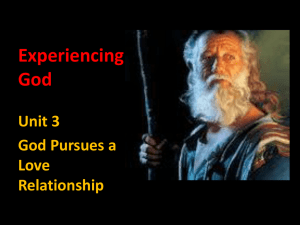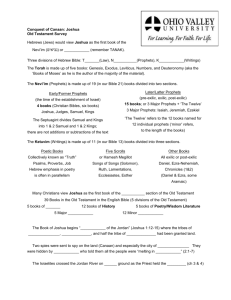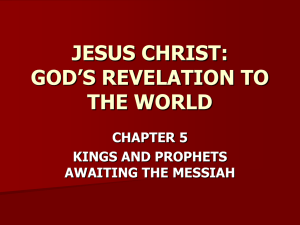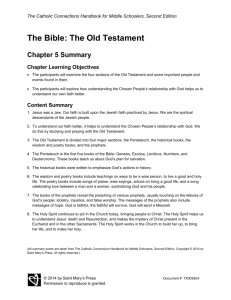In the Days of the Prophets
advertisement
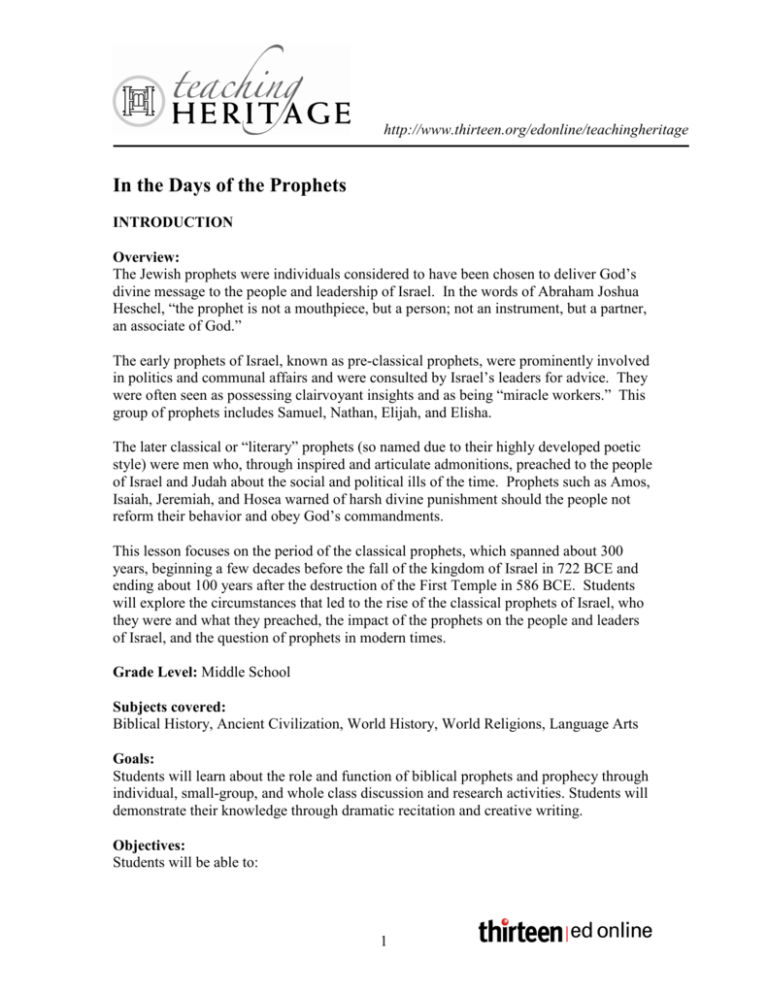
http://www.thirteen.org/edonline/teachingheritage In the Days of the Prophets INTRODUCTION Overview: The Jewish prophets were individuals considered to have been chosen to deliver God’s divine message to the people and leadership of Israel. In the words of Abraham Joshua Heschel, “the prophet is not a mouthpiece, but a person; not an instrument, but a partner, an associate of God.” The early prophets of Israel, known as pre-classical prophets, were prominently involved in politics and communal affairs and were consulted by Israel’s leaders for advice. They were often seen as possessing clairvoyant insights and as being “miracle workers.” This group of prophets includes Samuel, Nathan, Elijah, and Elisha. The later classical or “literary” prophets (so named due to their highly developed poetic style) were men who, through inspired and articulate admonitions, preached to the people of Israel and Judah about the social and political ills of the time. Prophets such as Amos, Isaiah, Jeremiah, and Hosea warned of harsh divine punishment should the people not reform their behavior and obey God’s commandments. This lesson focuses on the period of the classical prophets, which spanned about 300 years, beginning a few decades before the fall of the kingdom of Israel in 722 BCE and ending about 100 years after the destruction of the First Temple in 586 BCE. Students will explore the circumstances that led to the rise of the classical prophets of Israel, who they were and what they preached, the impact of the prophets on the people and leaders of Israel, and the question of prophets in modern times. Grade Level: Middle School Subjects covered: Biblical History, Ancient Civilization, World History, World Religions, Language Arts Goals: Students will learn about the role and function of biblical prophets and prophecy through individual, small-group, and whole class discussion and research activities. Students will demonstrate their knowledge through dramatic recitation and creative writing. Objectives: Students will be able to: 1 http://www.thirteen.org/edonline/teachingheritage 1. examine the roles and functions that prophets and prophecy played in ancient Israel; 2. explore the history of ancient Israel during the time of the Prophets; 3. analyze biblical texts and prophetic statements; 4. compare and contrast prophetic writings; 5. compose newspaper articles from the perspective of either a prophet or an ancient Israelite; 6. identify individuals working to address social and political ills in contemporary life –modern-day “prophets.” Suggested Time Frame: Three to four 45-minute sessions LEARNING ACTIVITIES Before you begin: Teachers should be sure to explore all bookmarked pages of the DVD-ROM used in this lesson. Introductory Activity: Who Were the Prophets? 1. Explain to the class that they are going to be studying the Biblical Prophets of Ancient Israel. Ask students to brainstorm what they know about biblical prophets and capture their ideas on chart paper. 2. Ask the students what they know about the prophets of ancient Israel: • Who were they? • What did they say and do? • Why were they important? Leave room for other ideas to be added as the lesson progresses. 3. Mention to students that, in contrast to the English word prophet, which means “one who predicts the future,” the Hebrew word for prophet, “navi,” means “spokesman for God.” According to Jewish tradition, prophets were chosen by God, sometimes against their will, and were compelled to deliver the divine message, even if they personally disagreed with it or if the people did not wish to hear it. Learning Activity 1: The World of the Prophets Most scholars date the emergence of the classical prophets to the middle of the eighth century BCE, approximately 150 years after the death of King Solomon and the division of the monarchy into the northern kingdom of Israel and the southern kingdom of Judah. This was a time of religious, political, and social instability, including a growing divide between those of rank and privilege and the common people. The prophets were 2 http://www.thirteen.org/edonline/teachingheritage outspoken critics of the corrupt and irreverent ways of the leadership and the Israelite people. The division of the monarchy into two kingdoms after King Solomon’s death caused many changes within Israelite society. 1. View the video Prophets, stopping at “And Jerusalem became rubble....” 2. After viewing the video, ask the class: • What were the social issues of the day that the Prophets were responding to? • What was the role of the Prophets? What did they speak for and against? • What did they warn would befall the Israelites if their evil ways continued? 3. Allow students several minutes to discuss their answers with a partner. 4. Reconvene and discuss as a class, adding new information to the list created in the introductory activity. Guide students’ attention to notice that prophets condemn crimes against man and against God. Learning Activity 2: The Words of the Prophets The classical prophets stressed the importance of justice and morality as opposed to ritual alone. They called for righteous behavior such as caring for the needy and dealing honestly in business. The prophets pleaded with the people to change their behavior, warning that if they didn’t do so, they would lose their land and the favor of their God. Biblical Excerpts 1. Students will read biblical excerpts (on the screen or in Bibles) and discuss the content of each one, using the questions as a guide. 2. The texts present four different classical prophets whose messages admonish the leadership and people for social, political, and religious injustices and corruption. After reading the texts, have the students analyze the messages offered by these prophets. 3. Students should consider the following questions as they read each of the prophetic texts. You may write these questions on the board and have the class answer them together, or you may choose to split the class into groups and use the handout with the questions listed on it. • • • What social ills does the Prophet talk about? What criticisms and/or demands does he make? What consequences does he threaten? 3 http://www.thirteen.org/edonline/teachingheritage • Do you think the prophet’s message is presented in a way that would cause the people to listen? Why or why not? # AMOS was a humble shepherd who spoke out fearlessly about social injustice (slavery, poverty, war, oppression), the excesses of the rich and their exploitation of the poor, and what he considered a corrupt priesthood. In They Sell the Righteous for Silver (Amos 2:4-8, 12-13), Amos states that God was aware of all of the immoral and blasphemous acts committed by the Israelites, and divine punishment was inevitable. • Read the text on the left, then read the document. • Discuss the questions in the handout/on the board. # MICAH lived in the latter part of the eighth century BCE, during which the Northern Kingdom of Israel fell to Assyria. He harshly criticized political and religious leaders for the injustices of society. In Micah Denounces Wicked Rulers (Micah 3:1-7, 9-12), Micah describes the corruption and inequity of the Judean people, and prophesies divine punishment for all of Judah’s inhabitants. • Read the text on the left, then read the document. • Discuss the questions in the handout/on the board. # ISAIAH lived in the eighth century BCE, a period when Assyria conquered Israel, and Judah survived by agreeing to pay tribute to Assyria. Isaiah’s fiery messages warned of disaster, but he also offered visions of peace. The biblical book of Isaiah relates to both the period of the First Temple (chapters 1-39) and the period of the return to the land of Israel following the Babylonian Exile (chapters 40-66). It is believed to include the words of more than one prophet, as most scholars believe later chapters were written two centuries after the prophet Isaiah’s death (after the destruction of the Temple in 586 BCE) by an author referred to as the Second Isaiah. In The Song of the Unfruitful Vineyard (Isaiah 5:1-10), Isaiah uses poetic language to metaphorically compare the people of Judah to God’s vineyard, which has not yielded the expected bounty despite the care with which it was planted. • Read the text on the left, then read the document. • Discuss the questions in the handout/on the board. 4 http://www.thirteen.org/edonline/teachingheritage # JEREMIAH prophesized during the late seventh and early sixth centuries BCE, during the years before Judah was conquered by the Babylonians. His fiery sermons against the Temple cult of his day nearly resulted in his being killed. He was forbidden to go near the Temple area, his writings were burned, and he was twice arrested by the king; nevertheless, he continued prophesizing about Judah’s ultimate demise. Yet Jeremiah is also remembered for his messages of comfort and hope. In A Prophesy of Exile (Jeremiah 25:4, 8-14), Jeremiah tells the people that God will bring the Babylonian King Nebuchadnezzar against Judah, resulting in a seventy-year exile of the Judean people in Babylon. • Read the text on the left, then read the document. • Discuss the questions in the handout/on the board. Comparing the Prophesies 4. When students have read all the passages, ask the class to review the prophetic messages and consider: What do all of these prophesies have in common? How are they different? 5. Ask students, based upon the descriptions they’ve read, whether they think the people and the leadership of Israel and Judah would have listened to the prophets? Why or why not? Learning Activity 3: The Impact of the Prophets Ultimately, the predictions of the prophets came to pass, as devastation befell the people of Israel and Judah; however, in the face of great tragedy, the prophets offered hope for the future. 1. According to Abba Eban, “the people of Judah had been humbled by the sword and they were now to rely on something more powerful than the sword – the power of the word.” Ask students what they think this means. • How can words be more powerful than weapons? • Why do you think the “power of the word” would be more effective at that moment in history than it had been prior to the exile? 2. Read page two of the introductory panel to the Explore Topic section for Prophets: “They preached in public and in private, but most did not commit their words to writing. This was done later by scribes who edited and preserved their sayings--some of the most powerful poetic expressions of all word literature.” 5 http://www.thirteen.org/edonline/teachingheritage 3. The words of the prophets were not written down until much later. Ask the class to consider: what is the benefit of hindsight? Culminating Activities: 1. For a class project, have students imagine that they are news reporters for “The Prophetic Times.” Student assignments may include news articles reporting from a “neutral” perspective, editorials written by prophets and by Israelite leaders (these would be opposing perspectives), and artwork/cartoons. Students should cover the political and social situation during the time of the Prophets; the specific concerns, words, and prophetic style of the Prophets; and the location and place of where the prophet is preaching. 2. For homework, have students memorize selections from a text studied in Activity Two or another biblical text of the same prophets and prepare a dramatic oral prophetic presentation. • In class, students will assume the role of their selected prophet and convincingly and powerfully preach their text, while the listening audience assumes the role of the wealthy and corrupt living in Ancient Israel and/or Judah. • The class can discuss whether or not they would have been persuaded by the particular prophet’s message. • Ask students if the method of communication (i.e. written or oral) impacts the effectiveness of the passage. Why or why not? Extension Activity (Optional): Are There Still Prophets Among Us? Although the traditional view is that prophesy disappeared with the destruction of the First Temple, there are many people, contemporary scholars and rabbis among them, who believe that there continue to be “prophets” in every generation – people who champion the cause of the needy, who are the “social conscience” of the community. Note to the teacher: For more in-depth study, see Rabbi Abraham Joshua Heschel’s books The Prophets and Prophetic Inspiration After the Prophets: Maimonides and Others. 1. Read to the class the following definitions of a prophet. You may choose to write these quotes on the board or use the handout. • “A prophet is a person who sees the world with the eyes of God, who holds God and humanity in one thought at one time, at all times.” (Abraham Joshua Heschel) 6 http://www.thirteen.org/edonline/teachingheritage • “Prophets are men and women who believed they were called to a special task in speaking God’s word, and who served as the moral and spiritual leaders of their time.” (Rabbi Michael Shire) 2. Divide students into groups of three to four. Students should: • Read and discuss both of these definitions and discuss the role of the classical prophets. • Have the students think about individuals living in recent times who might be considered modern-day or contemporary prophets (e.g. Martin Luther King, Nelson Mandela, Ghandi, etc.). Have each group pick one of these people to profile. • Have each group write a brief description of the selected person’s achievements and goals. • Have each group explain their choice to the class, including an evaluation of whether the group considers this individual a modern-day prophet. 3. As a whole class, generate a list of contemporary social issues that the students believe should be addressed by modern-day prophets, and discuss why these issues are of such importance. • You might choose to post these issues in the classrooms as reminders of the ongoing need to find and perhaps BE “prophets” in our day. • The class may decide to undertake a social action project to address one or more of these issues. MATERIALS • • • • • Tanakh/Bible For optional activities, Rabbi Abraham Joshua Heschel’s, The Prophets (New York: HarperCollins, 2001), and Prophetic Inspiration After the Prophets: Maimonides and Other Medieval Authorities (Jersey City, NJ: KTAV Publishing House, Inc., 1996) Handout with questions on biblical excerpts. Handout with modern quotes on prophets. 7 http://www.thirteen.org/edonline/teachingheritage STANDARDS Historical Understanding Standard 2: Understands the historical perspective Levels III and IV Language Arts Standards 1-3: Uses the general skills and strategies of the writing process; Uses the stylistic and rhetorical aspects of writing; Uses grammatical and mechanical conventions in written compositions Theatre Standard 2: Uses acting skills Levels III and IV World History Standard 7: Understands technological and cultural innovation and change from 1000 to 600 BCE Level III, Benchmark 4: Understands social development and religious beliefs of Jewish civilization (e.g., the course of development of the Jewish kingdoms and the Jews' maintenance of religious and cultural traditions despite destruction of these kingdoms, the significance of the Torah in Judaism) Level IV, Benchmark 2: Understands events that led to the spread of Judaism (e.g., the significance of the Babylonian captivity for the subsequent history and survival of Judaism, the significance of the Jewish diaspora for the transmission of Judaism in the Mediterranean region and Southwest Asia) 8 http://www.thirteen.org/edonline/teachingheritage DVD-ROM BOOKMARKS Prophets (Video > A People is Born > Two Kingdoms > Prophets) They Sell the Righteous for Silver (Video > A People is Born > Two Kingdoms > Prophets > Explore Topic > Historical Documents > They Sell the Righteous for Silver) Micah Denounces Wicked Rulers (Video > A People is Born > Two Kingdoms > Prophets > Explore Topic > Historical Documents > Micah Denounces Wicked Rulers) The Song of the Unfruitful Vineyard (Video > A People is Born > Two Kingdoms > Prophets > Explore Topic > Historical Documents > The Song of the Unfruitful Vineyard) A Prophesy of Exile (Video > A People is Born > Two Kingdoms > Prophets > Explore Topic > Historical Documents > A Prophesy of Exile) Explore Topic (Video > A People is Born > Two Kingdoms > The Prophets > Explore Topic) 9 http://www.thirteen.org/edonline/teachingheritage Handout #1 In the Days of the Prophets Learning Activity 2: The Words of the Prophets Questions to consider while reading excerpts from Amos, Micah, Isaiah, and Jeremiah. • What social ills does the Prophet talk about? • What criticisms and/or demands does he make? • What consequences does he threaten? • Do you think the prophet’s message is presented in a way that would cause the people to listen? Why or why not? Note: In each Heritage document, click on the hypertext links. They reveal information to help you better understand the document and answer the questions. 10 http://www.thirteen.org/edonline/teachingheritage Handout #2 In the Days of the Prophets Are There Still Prophets Among Us? Consider the following quotes from modern-day Jewish scholars: • “A prophet is a person who sees the world with the eyes of God, who holds God and humanity in one thought at one time, at all times.” (Abraham Joshua Heschel) • “Prophets are men and women who believed they were called to a special task in speaking God’s word, and who served as the moral and spiritual leaders of their time.” (Rabbi Michael Shire) Read and discuss both of these definitions and discuss the role of the classical prophets. Are there any modern-day figures you consider to be prophets? 11
